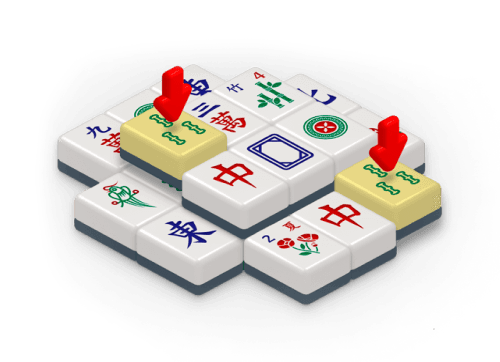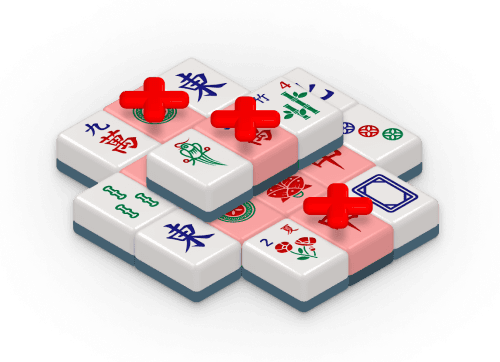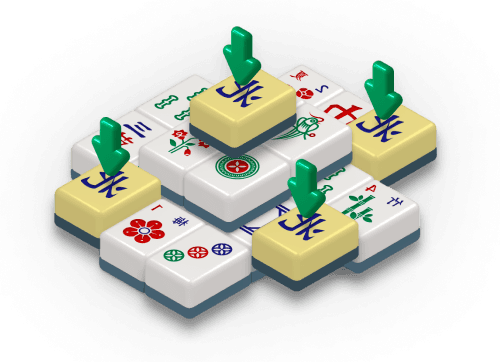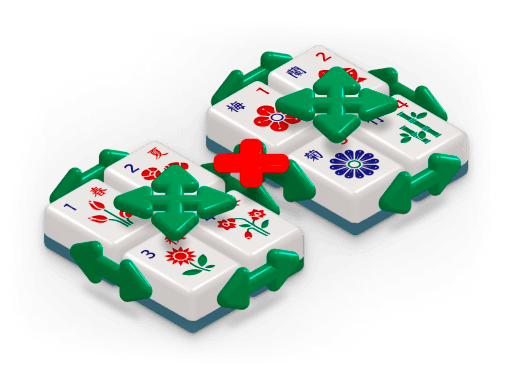
Loading...
Mahjong Solitaire
Mahjong solitaire is one of the most popular ways to play solitaire in the world, making a great way to enjoy a version of the game by yourself. It’s a tile matching game in which you must find pairs of tiles to be cleared away from the board until all the tiles in the spread are gone. Mahjong solitaire is a simple, meditative game which nonetheless requires a good deal of strategic thinking, making it a great game to pick up that is difficult to master. Today, we’re going to look at everything you need to know to get started playing free Mahjong solitaire, so let’s dive into it.








Bonus tiles
There are eight Mahjong bonus tiles that work differently than the rest of the game’s tiles. Let’s break down each of them and what they mean for the game. There are four flower tiles. Firstly, there is the plum blossom flower, a symbol of winter and at the same time a herald of spring. The number 2 flower tile is the orchid, embodying beauty and refinement. Chrysanthemums are used as the third tile in this series, with their associations of happiness and longevity. Finally, tile number four in the flower set is the bamboo tile. This is not to be confused with the bamboo suited tiles. The other four bonus tiles are the season tiles. Spring is the first season tile in the Mahjong bonus tiles, the start of the year and the reprieve from winter. Summer comes next, represented sometimes by flourishing summer grasses on the tile. Fall comes after the summer tile, associated with the colour white and both courage and sadness in Chinese culture. Finally, winter is the last of the bonus tiles in Mahjong—a chill, sombre embodiment of the finality of the season in the game.
How to play Mahjong Solitaire
Solitaire Mahjong is a game about matching up pairs of tiles from a set of 144 tiles. The tiles are presented in one of several formations, with some formations being more difficult to complete than others. The most common formation used in mah jong solitaire is the turtle formation. The patterns are layered, as we’ll look at, meaning that not all tiles are accessible right away. Let’s look at the key elements of play in the game of Mahjong solitaire.


Unlocking tile pairs
If tiles are blocked in Mahjong solitaire by tiles to either side of them, then another key part of the gameplay is unlocking pairs of tiles or individual tiles to be later paired up. Tiles are also layered, meaning that some tiles will be on top of others at the start. Naturally, the tiles underneath cannot be accessed until the tiles above and to their sides are cleared. When you find a pair of tiles, both with exposed sides, those tiles are removed and any tiles that are then exposed are unlocked.

Choosing tile pairs
So, the game is about finding matching pairs—but there is more to it than that. How you choose matching pairs is really important, as it is entirely possible to get completely stuck in a game of Mahjong solitaire and not be able to make any more moves. We’ll look at some tips for winning shortly, but in general you should try and think multiple steps ahead before you make a move, and always play strategically. In some cases, the rules allow you to shuffle the tiles a certain number of times if you get stuck, but this is not always the case in Mahjong solitaire.

Bonus tiles
While 136 of the 144 tiles are matching pairs, there are also eight total bonus tiles in Mahjong solitaire classic. These are the seasons tiles and the flowers tiles, each with four tiles. You must build the full sequences of these tiles in order to remove them from the board. Seasons tiles match only between all other seasons tiles, and flower tiles match only with all other flower tiles.
Mahjong tips
Mahjong solitaire classic free is a game that is fairly easy to pick up, but ultimately very hard to master. Some basic tips for getting started include the following:
1. Always think multiple steps ahead
As mentioned, typically, the rules of the game do not allow you to shuffle if you get stuck—thus, it can often be a single move that gets players stuck and forcing them to restart. When we first start playing the game, it’s tempting to simply straight away match any pairs we can see. While this might be fine at the beginning of the game, as the game goes on, you’ll need to think more and more carefully about each move you make. Think about what will be exposed whenever you make a move.
2. Start with simple patterns
There are many ways to play Mahjong solitaire as you can effectively lay out the tiles anyway you like as long as there are three layers. When you’re getting started playing the game, the common turtle formation is the best way to start. This will be the easiest to complete and will give you a good way into the game and its rules without being overwhelmingly difficult.
3. Remain patient and put your memory to work
Ultimately, Mahjong solitaire is a memory game, and so you’ve got to be patient and try to memorize the positions of as many tiles as possible. The greater your memory of the tiles and where they are, the better chance you’ll have of making the best possible move at a given moment. When shuffling is available, sometimes we might end up choosing the option to shuffle when in fact there were legal moves available.
These are the basic, starting tips for playing the game—now let’s look at some more advanced strategies for winning games of solitaire mahjongg.
Mahjong Strategies
Mahjong solitaire online is, to some extent, a game of chance, depending on how you are playing it. Depending on the hand you are dealt and the variation you’re playing in, it may be that certain deals are just not solvable. This is rare, though, and in general it is far more a game of strategy than of luck. Here are some of the best strategies for playing Mahjong solitaire:
1. Always play strategically
Every single move in Mahjong solitaire counts, and so you’ve got to think very carefully about each move. When the game starts out, scan the board and see what tiles are exposed and available for play right away. When you find a matching pair, think about what removing that pair would reveal, and compare that with other available matches to find the most advantageous move. Remember, a single wrong move can mean the end of the game if you aren’t able to shuffle the tiles.
2. Focus on long rows and high stacks
As the game starts, you’ll only have access to a limited number of tiles—then as the game goes on, more and more will be exposed. At the start of the game, high stacks of tiles and long rows will both cover many cards, so you’ll want to start by removing the tiles from these long stacks and opening up more options. At the very start of the game, focusing on the high stacks is the best way to move forward.
3. Open new tiles with every pair
Any pair that you make should expose new tiles. Choosing really obvious pairs is one of those impulses that you must learn to suppress to get good at Mahjong solitaire. If a pair is available, but at that point in the game it doesn’t expose any new tiles, then leave it and come back to it later. This sort of thing is bound to get you stuck.
4. Play lots of games
Though not strictly a strategy in itself, what is certainly the case is that you’ll probably struggle to completely clear your first few games of Mahjong solitaire. It’s a tricky game, and mistakes can be costly. Reading up on strategy is really important, but there’s no substitute for having experience under your belt. The more games you play, the better you will get at the game, and the greater chance you’ll have of winning.
5. Hone your memory
It cannot be stressed enough that memory is the most important aspect of the whole game, and so as you are playing more games, focus on improving your memory. The more you try to do this during games, and try to keep the full lay out of the tiles in your head, the more your memory will improve as you go along.
Armed with these strategies, you’ll be able to play free Mahjong with increasing success and you’ll find your play gets better and better really quickly. It’s natural to wonder, though, what the actual meaning of the tiles is in the game, so let’s look at this question.
Mahjong Tile meaning
Tiles and suits in free online Mahjong solitaire can be referred to by quite a few different names, and so their inherent meaning—if they even have such a thing—can get more than a little confusing. Let’s take a look at each type of tile.
Suits
There are three suits in Mahjong solitaire: they are most commonly referred to as dots, bamboo, and characters. Dots are sometimes also called stones, and bamboo are sometimes referred to as sticks. Characters are sometimes called numbers or thousands.
The round shape of the dots is said to represent a tong coin, with a square hole in the middle. Each character tile features the Chinese character 萬, or wán, meaning 10,000. Each of the other tiles then has a character above it, going from number one to number nine.
Bamboo is a bit different in Mahjong solitaire, as the first tile instead features a bird rather than a single bamboo stick. This bird is typically a sparrow or peacock. The rest of the tiles have two to nine sticks of bamboo on them.
Honors
The honors tiles, often referred to as bonus tiles in the context of Mahjong solitaire games, are two different tiles: usually the seasons and the flowers. In ordinary Mahjong, this category also features dragon tiles which are usually, but not always, excluded from Mahjong solitaire. The winds are North, East, South and West, and naturally the Seasons are Spring, Summer, Fall and Winter.
Bonus
Besides the tiles we’ve looked at in the honors category of Mahjong solitaire, there are also a couple of other bonus categories which are sometimes used in free online solitaire Mahjong. The flowers fall into this category, though the dragons can as well. You most commonly have a plum blossom, an orchid, chrysanthemum and bamboo. For the dragons, you have the red, green and white dragon.
| Type of tile | Tiles in the category | Meaning |
Suits | Dots/stones, bamboo/sticks, characters/numbers | Dots are representative of coins, bamboo seen to represent nature, characters are numbered tiles in Chinese |
Honors | Seasons, flowers | Mahjong solitaire usually uses seasons and flowers tiles, important natural motifs in Chinese folk imagery |
Bonus | Dragons, winds | Dragons are seen to be images of good luck in China, and the winds represent the cardinal directions |
Symbolic significance
All of these images used in Mahjong solitaire tiles are common motifs in Chinese art and culture, and they are all loaded with meaning of their own which would be readily apparent to many people in China and Asia more broadly. Dragons, for instance, are commonly seen as symbols of good luck and strength, and they can often be very advantageous in games of Mahjong solitaire.
The winds and the seasons are closely interlinked: the four directions of the wind reflecting the transitions of the seasons, such as the spring and fall equinoxes as well as the summer and winter solstices.
So, inherently, the images used in Mahjong do all have their own representative significance in China and to the people who originally conceived the games and the game pieces. But in the context of Mahjong solitaire, they do not necessarily “mean” anything for the actual game. The idea is just that they are all highly distinct and memorable pieces which you won’t confuse easily.
History of Mahjong Solitaire
What’s interesting about the history of Mahjong solitaire is that the game is far more recent than you might think. The original game which we call Mahjong was invented in the 19th Century, during the Qing Dynasty in China. This is a game played with four players, though usually with most of the tiles that we still use in Mahjong solitaire today. This game, then, is a couple of centuries old—but it would not be until 1981 that what we recognize as Mahjong solitaire first appeared.
Inventing Mahjong for the computer
As mentioned, Mahjong solitaire is much more commonly played on a computer, rather than with a physical set. While physical sets have become popular, the games can take a long time to set up, and so it’s harder to play multiple games at once. At the same time, the format plainly lent itself to solo play. With that in mind, in 1981, a version of Mahjong solitaire was designed for the PLATO computer system, which had itself been developed by the University of Illinois for educational purposes. The game was developed by a computer programmer called Brodie Lockard, a programmer who had been in hospital when someone brought him a physical board of Mahjong solitaire. Enamoured with the game, he decided to implement it into the PLATO system.
How Mahjong solitaire was popularized
In 1986, the program and computer game publisher Activision developed a version for the IBM PC, Commodore, Macintosh, and even the Atari ST. Ten million copies of Mahjong solitaire were sold, and the previously virtually unknown Mahjong solitaire was catapulted into enormous popularity and success. Classic Mahjong solitaire free, then, was really made popular as a computer program, even though it used the tiles of a much older game—and though Lockard himself claimed the game was based on an even older Chinese game known as “the turtle”.
Since then Mahjong solitaire has been included in countless different game and entertainment packs, such as the Best of Windows Entertainment Pack which was sold in the 1990s. All of this drove its popularity to the point that, at least in the west, many people are more familiar with this version than the original Mahjong game.
Conclusion
Mahjong solitaire might seem like a simple game, then, but there’s a lot more going on under the surface than you might at first think. The game is complex and layered, while at the same time being simple and easy to pick up. You’ll struggle to master it at first, but as with all the best games, you’ll catch on pretty quick and the game will make more and more sense to you. Mahjong solitaire is one of the best games to play by yourself and stimulate your brain and your memory skills.